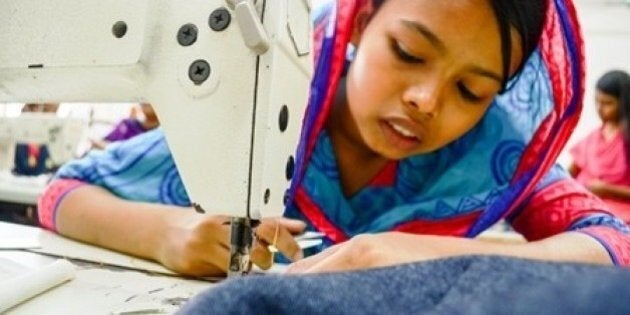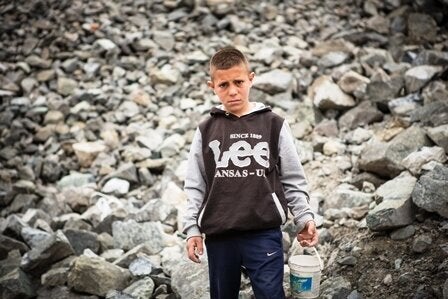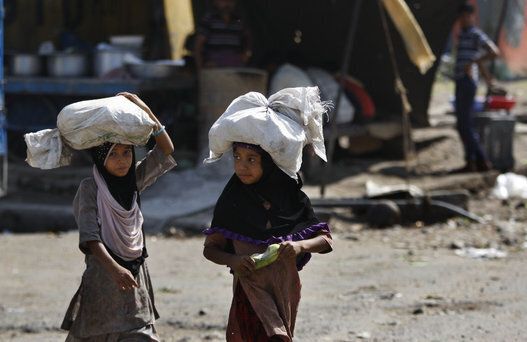
The little girl walked into the huge factory for the first time, leaving her childhood outside forever. "'I was too small,' she remembers of that day. "And I cried.'"
On International Day for the Abolition of Slavery, the quote is both heartbreaking and appropriate. Three guesses where it came from:
- A Charles Dickens novel, describing the horrors of child labour in late 18th and early 19th century Britain
- Poet William Blake's "dark, satanic mills"
- Historical descriptions of children abducted from Africa, to serve in the so-called "factories in the fields" of 18th century North America.
All of these sources describe children exploited in the worst kinds of child labour -- dirty, dangerous and degrading. But my quote came from elsewhere. The girl I described hasn't stepped out of the history books. She's alive and working today.
Bithi may have made the jeans that you're wearing right now. She's one of the thousands of Bangladeshi children piecing together designer jeans that she'll never be able to afford.
Abject poverty and a sick father has forced Bithi's family to send their two oldest daughters to the garment factories to sew designer clothes that will be sold in shops in Canada, the United States and other high-income countries. Every day, Bithi helps create a minimum of 480 pair of pants, earning the equivalent of about $1.20.
But is this slavery?
"Wait a minute," you might be saying. "That's not the same thing as slavery in North America. Bithi is not forced to work -- her family is choosing it. Her job could be the difference between life and death. Take it away, and the family starves."
This touches on one of the six myths about modern-day slavery -- that child workers actually have the choice about whether to labour in dirty, dangerous and degrading jobs.
Let's look at six of those myths here:
Myth #1: Times have changed. Not many children are working now.
A staggering 85 million of the world's children are involved in the worst kinds of child labour. I don't mean fetching water, gathering wood, or helping parents in the fields at harvest time. The work I'm referring to is dirty, dangerous and degrading. Like bending over a sewing machine for 12 hours a day until the soft, growing bones of a child's back are permanently bowed with the effort. Or handling dangerous dyes and chemicals in places like garment factories, fields, or plantations, without any kind of protective gear.
Myth #2: But that work is still a choice. Those children aren't forced to do it.
Let's explore the meaning of "forced." How many children do you know here in Canada who would allow a parent or younger sibling to die without food or medicine if there were something they could do to stop it? Without a parent to care for you, children in some of the world's poorest regions may have no choice but to live on the streets.
Myth #3: It's a way of life over there. Children don't expect any different.
Some children may resign themselves to working in hazardous jobs. But that doesn't mean the work doesn't jeopardize their safety, development and chance for a better future. And it doesn't mean that the child doesn't feel heartbreak over the many opportunities they will never have, because they've had to leave school to work full-time. Every child is full of potential and dreams for the future. When these things are ripped away, it hurts.
Myth #4: Those jobs help families survive. It would be wrong to take them away.
The first part is true. Bithi's $1.20 a day, for instance, could make a critical difference to her family. But this raises the question about why her money is necessary in the first place. Many parents become ill or disabled by working conditions they themselves have endured. Or there hasn't been enough money to seem medical treatment to prevent an illness from getting worse. If parents were paid fair wages for their labour and if safer working conditions meant they were less likely to be injured or killed on the job, fewer children would need to rely on jobs like Bithi's.

Keli and his older brother support their family by gathering ore for chrome, after their mother was killed on the job. Photo/World Vision
Myth #5: This is all terrible, but none of it is my fault.
No one means to put children in exploitative situations, but many Canadian shoppers are complicit without even knowing how. World Vision's "Sticker Shock" infographic shows that imports to Canada as seemingly innocent as sugar, shoes and cell phones come to us through supply chains which could well include child labour along the way. But because the supply chains are so long and complicated, it's very difficult for Canadian shoppers to know which companies are better than others about ensuring children aren't exploited.
Myth #6: The issue is so big and complicated! I can't do anything to help.
Like the abolitionists who fought the Transatlantic Slave Trade by using whatever gifts and resources they had, you can do small things to make a big difference. Here are two suggestions:
- Email companies you support, asking what they do to ensure that the products they offer for sale are child-labour free. The more questions companies receive, the more likely they are to act. Consider emailing them the following link: Behind Our Labels: 10 steps companies can take
- Sign a petition calling on Canadian companies and government to work toward making supply chains more transparent, so consumers know where to shop for child-labour free products. The UK's recently passed Modern Slavery Act will now require large to publically disclose their efforts to address modern slavery in their supply chains. We can do the same here!
MORE ON HUFFPOST:
